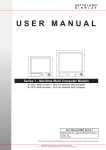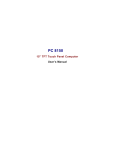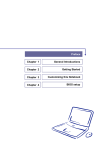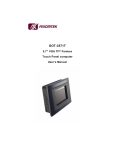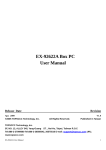Download 763.2KB - Axiomtek
Transcript
MPC170-831-DC All-In-One 17” Medical Grade PANEL PC User’s Manual Disclaimers This manual has been carefully checked and believed to contain accurate information. AXIOMTEK Co., Ltd. assumes no responsibility for any infringements of patents or any third party’s rights, and any liability arising from such use. AXIOMTEK does not warrant or assume any legal liability or responsibility for the accuracy, completeness or usefulness of any information in this document. AXIOMTEK does not make any commitment to update the information in this manual. AXIOMTEK reserves the right to change or revise this document and/or product at any time without notice. No part of this document may be reproduced, stored in a retrieval system, or transmitted, in any form or by any means, electronic, mechanical, photocopying, recording, or otherwise, without the prior written permission of AXIOMTEK Co., Ltd. ©Copyright 2008 AXIOMTEK Co., Ltd. All Rights Reserved July 2008, Version A1 Printed in Taiwan ii Safety Approvals CE Marking FCC Class B FCC Compliance This equipment has been tested in compliance with the limits for a Class B digital device, pursuant to Part 15 of the FCC Rules. These limits are meant to provide reasonable protection against harmful interference in a residential installation. If not installed and used in accordance with proper instructions, this equipment might generate or radiate radio frequency energy and cause harmful interference to radio communications. However, there is no guarantee that interference will not occur in a particular installation. If this equipment does cause harmful interference to radio or television reception, which can be determined by turning the equipment off and on, the user is encouraged to try to correct the interference by one or more of the following methods: 1. Reorient or relocate the receiving antenna. 2. Increase the separation between the equipment and receiver. 3. Connect the equipment to another outlet of a circuit that doesn’t connect with the receiver. 4. Consult the dealer or an experienced radio/TV technician for help. Shielded interface cables must be used in order to comply with the emission limits. iii Safety Precautions Before getting started, read the following important safety precautions. 1. 2. 3. 4. 5. 6. 7. 8. 9. 10. iv The MPC170-831-DC does not come equipped with an operating system. An operating system must be loaded first before installing any software into the computer. Be sure to ground yourself to prevent static charge when installing the internal components. Use a grounding wrist strap and place all electronic components in any staticshielded devices. Most electronic components are sensitive to static electrical charge. Disconnect the power cord from the MPC170-831-DC before any installation. Be sure both the system and external devices are turned OFF. A sudden surge of power could ruin sensitive components that the MPC170-831-DC must be properly grounded. Make sure it is the correct voltage of the power source before connecting the equipment to the power outlet. The brightness of the flat panel display will be getting weaker as a result of frequent usage. However, the operating period varies depending on the application environment. Turn OFF the system power before cleaning. Clean the system using a cloth only. Do not spray any liquid cleaner directly onto the screen. The MPC170-831-DC may come with or w/o a touchscreen. Although the touchscreen is chemical resistant, it is recommended that you spray the liquid cleaner on a cloth first before wiping the screen. In case your system comes without the touchscreen, you must follow the same procedure and not spray any cleaner on the flat panel directly. Avoid using sharp objects to operate the touchscreen. Scratches on the touchscreen may cause malfunction or internal failure to the touchscreen. The flat panel display is not susceptible to shock or vibration. When assembling the MPC170-831-DC, make sure it is securely installed. Do not leave this equipment in an uncontrolled environment where the storage temperature is below -20℃ or above 60℃. It may damage the equipment. External equipment intended for connection to signal 11. input/out or other connectors, shall comply with relevant UL/IEC standard (e.g. UL 60950 for IT equipment and UL 60601-1/IEC 60601 series for medical electrical equipment). In addition, all such combinations shall comply with the standard IEC 60601-1-1, safety requirements for medical electrical systems. Equipment not complying with UL 606011 shall be kept outside the patient environment, as defined in the standard. Do not open the system’s back cover. If opening the cover for maintenance is a must, only a trained technician is allowed to do so. Integrated circuits on computer boards are sensitive to static electricity. To avoid damaging chips from electrostatic discharge, observe the following precautions: z Before handling a board or integrated circuit, touch an unpainted portion of the system unit chassis for a few seconds. This will help to discharge any static electricity on your body. z When handling boards and components, wear a wristgrounding strap, available from most electronic component stores. Classification 1. 2. 3. 4. 5. Degree of production against electric shock: not classified Degree of protection against the ingress of water: IPX1 Equipment not suitable for use in the presence of a flammable anesthetic mixture with air or with oxygen or nitrous oxide. Mode of operation: Continuous Type of protection against electric shock: Class I equipment v General Cleaning Tips You may need the following precautions before you begin to clean the computer. When you clean any single part or component for the computer, please read and understand the details below fully. 1. 2. 3. 4. 5. 6. When you need to clean the device, please rub it with a piece of dry cloth. Be cautious of the tiny removable components when you use a vacuum cleaner to absorb the dirt on the floor. Turn the system off before you start to clean up the component or computer. Never drop the components inside the computer or get circuit board damp or wet. Be cautious of all kinds of cleaning solvents or chemicals when you use it for the sake of cleaning. Some individuals may be allergic to the ingredients. Try not to put any food, drink or cigarette around the computer. Cleaning Tools: Although many companies have created products to help improve the process of cleaning your computer and peripherals users can also use household items to clean their computers and peripherals. Below is a listing of items you may need or want to use while cleaning your computer or computer peripherals. Keep in mind that some components in your computer may only be able to be cleaned using a product designed for cleaning that component, if this is the case it will be mentioned in the cleaning. z Cloth: A piece of cloth is the best tool to use when rubbing up a component. Although paper towels or tissues can be used on most hardware as well, we still recommend you to rub it with a piece of cloth. z Water or rubbing alcohol: You may moisten a piece of cloth a bit with some water or rubbing alcohol and rub it on the computer. Unknown solvents may be harmful to the plastics parts. z Vacuum cleaner: Absorb the dust, dirt, hair, cigarette particles, and other particles out of a computer can be one of the best methods of cleaning a computer. Over time these items can restrict the airflow in a computer and cause circuitry to corrode. vi z z Cotton swabs: Cotton swaps moistened with rubbing alcohol or water are excellent tools for wiping hard to reach areas in your keyboard, mouse, and other locations. Foam swabs: Whenever possible it is better to use lint free swabs such as foam swabs. Note We strongly recommended that you should shut down the system before you start to clean any single components. Please follow the steps below: 1. Close all application programs 2. Close operating software 3. Turn off power switch 4. Remove all device 5. Pull out power cable vii Scrap Computer Recycling If the computer equipments need the maintenance or are beyond repair, we strongly recommended that you should inform us as soon as possible for the suitable solution. For the computers that are no longer useful or no longer work well, please contact us for recycling and we will make the proper arrangement. Trademarks Acknowledgments AXIOMTEK is a trademark of AXIOMTEK Co., Ltd. IBM, PC/AT, PS/2, VGA are trademarks of International Business Machines Corporation. ® ® Intel and Pentium are registered trademarks of Intel Corporation. MS-DOS, Microsoft C and QuickBASIC are trademarks of Microsoft Corporation. VIA is a trademark of VIA Technologies, Inc. SST is a trademark of Silicon Storage Technology, Inc. UMC is a trademark of United Microelectronics Corporation. Other brand names and trademarks are the properties and registered brands of their respective owners. FCC Safety This device complies with Part 15 FCC Rules. Operation is subject to the following two conditions: (1) this device may not cause harmful interference, and (2) this device must accept any interference received including interference that may cause undesired operation. viii UL Module Description MPC170-831-DC DC module is developed to suitable for the Classification Mark requirement. Safty Symbol Description Medical equipment with respect to electric shock, fire and mechanical hazards only in accordance with UL 60601-1, and CAN/CSA C22.2 NO. 601.1 Danger of explosion if the system is on running. Ground wire Protective Ground wire ix Table of Contents Disclaimers ........................................................................................................... ii Safety Approvals ................................................................................................. iii Safety Precautions ...............................................................................................iv Classification .........................................................................................................v General Cleaning Tips .........................................................................................vi Scrap Computer Recycling ...............................................................................viii FCC Safety ..........................................................................................................viii UL Module Description ....................................................................................... ix Safty Symbol Description ................................................................................... ix Chapter 1 Introduction .................................................................... 1 1.1 1.2 1.3 1.4 1.5 1.6 General Description................................................................................. 1 System Specifications ............................................................................. 3 1.2.1 Main CPU Board .............................................................................. 3 1.2.2 I/O System....................................................................................... 3 1.2.3 System Specification ....................................................................... 4 Dimensions.............................................................................................. 5 I/O Outlets ............................................................................................... 6 Packing List ............................................................................................. 8 Power Switch........................................................................................... 8 Chapter 2 Hardware Installation .................................................... 9 2.1 2.2 2.3 2.4 2.5 2.6 Installing the the Hard Disk Drive ............................................................ 9 Installing the Add-On Card .................................................................... 16 Mountings – Wallmount/VESA .............................................................. 23 Installing Desktop Stand (Optional)....................................................... 24 Installing Memory Module ..................................................................... 30 Installing Wireless Module (Optional).................................................... 34 Chapter 3 Phoenix-Award BIOS Utility........................................ 39 3.1 3.2 3.3 3.4 3.5 3.6 3.7 3.8 3.9 3.10 3.11 3.12 3.13 3.14 3.15 x Entering Setup....................................................................................... 39 Control Keys .......................................................................................... 40 Getting Help .......................................................................................... 40 The Main Menu ..................................................................................... 41 Standard CMOS Setup Menu................................................................ 42 Advanced BIOS Features...................................................................... 45 Advanced Chipset Features .................................................................. 50 Integrated Peripherals ........................................................................... 53 Power Management Setup.................................................................... 57 PnP/PCI Configuration Setup................................................................ 60 PC Health Status................................................................................... 62 Frequency/Voltage Control.................................................................... 63 Load Optimized Defaults ....................................................................... 64 Set Supervisor/User Password ............................................................. 65 Save & Exit Setup ................................................................................. 66 3.16 Exit Without Saving ............................................................................... 67 Chapter 4 Driver Installation......................................................... 69 4.1 4.2 System .................................................................................................. 69 Touch Screen ........................................................................................ 70 4.2.1 Specification ................................................................................... 70 4.2.2 Driver Installation- Windows 98/2000/XP/CE.NET/XP-Embedded 71 xi MEMO xii MPC170-831-DC Series Panel PC User’s Manual Chapter 1 Introduction This chapter contains general information and detailed specifications of the MPC170-831-DC. Chapter 1 includes the following sections: 1.1 General Description System Specification Dimensions I/O Outlets Package List General Description The MPC170-831-DC is a medical grade and fanless touch panel computer, and is equipped with a 17” TFT LCD display and low power ® ® ® consumption CPU, the LV Intel Core2 Duo L7400 or ULV Intel ® ® Celeron M 423. The MPC170-831-DC supports Windows XP, ® Windows XP embedded, and Linux. The panel is also designed with IPX1 water resistant and able to install a USB wireless module for wireless communication. ¾ Reliable and Stable Design The MPC170-831-DC adopts the fanless cooling system and the anti-vibration hard-drive bay, which makes it especially suitable for vibration environments, best for POC (Point of Care) application. ¾ Flexibility – a PCI Slot The MPC170-831-DC offers a PCI slot which allows for extended communication, control or capture card, which can be used for different medical application requirements. Introduction 1 MPC170-831-DC Series Panel PC User’s Manual ¾ Embedded O.S. Supported ® The MPC170-831-DC not only supports Windows XP, but ® also supports embedded OS, such as Windows XP embedded and Linux. For storage device, the MPC170-831DC supports 2.5" HDD or USB-DOM. ¾ Medical-grade Product Design The MPC170-831-DC has an incredible design that can be used in different medical environments. z Certify with Medical Certification z Whole Unit IPX1 Water Resistant z Whole Unit Fanless Design z Compact with PCI Expansion Design z Excellent ID and User-Friendly Design 2 Introduction MPC170-831-DC Series Panel PC User’s Manual 1.2 System Specifications 1.2.1 Main CPU Board CPU z z z z ® ® ® ® LV Intel Core2 Duo L7400 or ULV Intel Celeron M 423 System Chipset ® Intel 945GME + ICH7M BIOS Phoenix-Award BIOS, 4Mbit with RPL/PXE LAN Boot ROM, SmartView and Customer CMOS Backup System Memory 1.2.2 Two 240-pin DDR2 DIMM max. up to 4GB(The actual max. capacity will be less depending on system configuration) I/O System Standard I/O z Three serial ports with power, two RS-232 and one RS232/422/485 jumper selectable Four USB ports 2.0 compliant One Firewire Port Two 10/100/1000 Base-T Ethernet LAN Two PS/2 mouse and keyboard One Mic-in, one Line-out One VGA out (supports DualView) Ethernet z Realtek RTL 8111B PCI-E Gigabit Ethernet Two 10/100/1000 Base-T Ethernet LAN z Expansion Slot One PCI Slot for 32-bit/66 MHz Introduction 3 MPC170-831-DC Series Panel PC User’s Manual 1.2.3 System Specification 17” SXGA TFT LCD Brightness -- 420 nits Resolution -- 1280 x 1024 Disk Drive Supports one 2.5” SATA HDD Power Supply ATX150W 24VDC Power Supply Power Input 18-36VDC, 10-5A Fuse Rating Fuse 3.15A/250V Slow Blow 5φ* 20mm Glass Body Optical Drive Compact 24X CD-ROM or Optional 8X/24X Combo Drive Expansion Slot One PCI Slot Net Weight 9kg (19.8lb) Dimension 439mm (W) x 376.5mm (H) x 92mm (D) z z z z z z z z z z Operation Temperature 0℃~ -40℃; Relative Humidity 10% ~ 95% NOTE All specifications and images are subject to change without notice. 4 Introduction MPC170-831-DC Series Panel PC User’s Manual 1.3 Dimensions The following diagrams show you dimensions and outlines of the MPC170-831-DC. Introduction 5 MPC170-831-DC Series Panel PC User’s Manual 1.4 I/O Outlets The following figures show you the locations of the MPC170-831-DC I/O outlets. 6 Introduction MPC170-831-DC Series Panel PC User’s Manual No Connector No Connector 1 BRIGHTNESS ADJUST 10 SPEAKER (R) 2 VOLUME ADJUST 11 PC/2 FOR K/B & M/S 3 POWER LED 12 VGA PORT 4 MICROPHONE 13 USB PORTS X 4 5 POWER SWITCH 14 MIN-IN/LINE-OUT 6 COM 1 15 DC POWER CONNECTOR 7 ETHERNET PORT X 2 16 COM 2 8 FIREWIRE PORTS 17 COM 3 9 PCI EXPANSION 18 SPEAKER (L) Introduction 7 MPC170-831-DC Series Panel PC User’s Manual 1.5 Packing List The package bundled with your MPC170-831-DC should contain the following items: MPC170-831-DC Unit x 1 CD x 1 (For Driver and User’s Manual) Quick Manual x 1 CD-ROM Cover x 2 SATA cable x 1 Cable Management Kit x 2 M4 x 8 Screws x 4 (for VESA Mounting) M3 x 5 Screws x 2 (for Cable Management Kit) z z z z z z z z If you can not find this package or any items are missing, please contact AXIOMTEK distributors immediately. 1.6 Power Switch Please use the following power switch for system power-on or poweroff. 8 Introduction MPC170-831-DC Series Panel PC User’s Manual Chapter 2 Hardware Installation The MPC170-831-DC is convenient for your various hardware configurations, such as HDD (Hard Disk Drive), CF (CompactFlash™) card, and more. The chapter 2 will show you how to install the hardware. It includes: 2.1 Installing the the Hard Disk Drive The MPC170-831-DC offers a convenient drive bay module for users to install HDD. The MPC170-831-DC offers users one 2.5” Hard Disk Drive for installation. Please follow the steps: Step 1 Turn off the MPC170-831-DC. Step 2 Unplug the DC power cable. Hardware Installation 9 MPC170-831-DC Series Panel PC User’s Manual Step 3 10 Release 8 screws which are marked on the following picture. Hardware Installation MPC170-831-DC Series Panel PC User’s Manual Step 4 Remove the heatsink. Hardware Installation 11 MPC170-831-DC Series Panel PC User’s Manual Step 5 12 Prepare HDD Assembly Parts - HDD Bracket x 1 - 2.5inch HDD (Parallel ATA I/F) - Screws x 4 Hardware Installation MPC170-831-DC Series Panel PC User’s Manual Step 6 Assembly the HDD with HDD bracket. Hardware Installation 13 MPC170-831-DC Series Panel PC User’s Manual Step 7 Assembly the HDD assembly into MPC170 by following screws. Step 8 Plug-in the SATA & Power Cable to HDD. 14 Hardware Installation MPC170-831-DC Series Panel PC User’s Manual Step 9 Assembly back the Heatsink. Hardware Installation 15 MPC170-831-DC Series Panel PC User’s Manual 2.2 Installing the Add-On Card If you need to install an Add-On card, please follow these steps for ADD-On card installation: Step 1 Turn off the MPC170-831-DC. Step 2 Unplug the DC power cable. Step 3 Release 8 screws which are marked on the following picture. 16 Hardware Installation MPC170-831-DC Series Panel PC User’s Manual Step 4 Remove the heatsink. Hardware Installation 17 MPC170-831-DC Series Panel PC User’s Manual Step 5 18 Remove the two screws of IO Cover. Hardware Installation MPC170-831-DC Series Panel PC User’s Manual Step 6 Release the PCI Holder and Dummy Plate. Hardware Installation 19 MPC170-831-DC Series Panel PC User’s Manual Step 7 20 Install the Add-On Card. Hardware Installation MPC170-831-DC Series Panel PC User’s Manual Step 8 Screw back the PCI Holder. Hardware Installation 21 MPC170-831-DC Series Panel PC User’s Manual Step 9 22 Install back the IO Cover & Heatsink. Hardware Installation MPC170-831-DC Series Panel PC User’s Manual 2.3 Mountings – Wallmount/VESA The MPC170-831-DC provides mounting for Wallmount and VESAArm by applying Wallmount/VESA Bracket as below. Hardware Installation 23 MPC170-831-DC Series Panel PC User’s Manual 2.4 Installing Desktop Stand (Optional) The MPC170-831-DC provides Desktop Stand (Option) that customer can install as below. Step 1 24 Prepare the parts of Desktop Stand. Hardware Installation MPC170-831-DC Series Panel PC User’s Manual Screw A Screw B Screw C Screw D Hardware Installation 25 MPC170-831-DC Series Panel PC User’s Manual Step 2 Assembly the Desktop Stand. Step 2-1 Assembly the Backplane (Use Screw C). 26 Hardware Installation MPC170-831-DC Series Panel PC User’s Manual Step 2-2 Assembly the Hinge Cover (Use Screw A). Hardware Installation 27 MPC170-831-DC Series Panel PC User’s Manual Step 2-3 Assembly the Base (Use Screw D). 28 Hardware Installation MPC170-831-DC Series Panel PC User’s Manual Step 3 Assembly the Desktop Stand onto MPC170-831-DC (Use Screw B). Hardware Installation 29 MPC170-831-DC Series Panel PC User’s Manual 2.5 Installing Memory Module Step 1 Turn-off the MPC170-831-DC. Step 2 Un-plug the DC power cable. Step 3 Release 8 screws which are marked on the following picture. 30 Hardware Installation MPC170-831-DC Series Panel PC User’s Manual Step 4 Remove the heatsink. Hardware Installation 31 MPC170-831-DC Series Panel PC User’s Manual Step 5 32 Install the Memory Module. Hardware Installation MPC170-831-DC Series Panel PC User’s Manual Step 6 Install the Heatsink. Hardware Installation 33 MPC170-831-DC Series Panel PC User’s Manual 2.6 Installing Wireless Module (Optional) You can follow the steps below to install an optional wireless module. Step 1 Turn-off the MPC170-831-DC. Step 2 Un-plug the DC power cable Step 3 Release 8 screws which are marked on the following picture. 34 Hardware Installation MPC170-831-DC Series Panel PC User’s Manual Step 4 Remove the heatsink. Hardware Installation 35 MPC170-831-DC Series Panel PC User’s Manual Step 5 36 Install Wireless Module & Plug-In the Antenna. Hardware Installation MPC170-831-DC Series Panel PC User’s Manual Step 6 Install back the Heatsink. Hardware Installation 37 MPC170-831-DC Series Panel PC User’s Manual MEMO 38 Hardware Installation MPC170-831-DC Series Panel PC User’s Manual Chapter 3 Phoenix-Award BIOS Utility The Phoenix-Award BIOS provides users with a built-in Setup program to modify basic system configuration. All configured parameters are stored in a battery-backed-up RAM (CMOS RAM) to save the Setup information whenever the power is turned off. 3.1 Entering Setup There are two ways to enter the Setup program. You may either turn ON the computer and press <Del> immediately, or press the <Del> and/or <Ctrl>, <Alt>, and <Esc> keys simultaneously when the following message appears at the bottom of the screen during POST (Power on Self Test). TO ENTER SETUP PRESS DEL KEY If the message disappears before you respond and you still want to enter Setup, please restart the system to try it again. Turning the system power OFF and ON, pressing the “RESET” button on the system case or simultaneously pressing <Ctrl>, <Alt>, and <Del> keys can restart the system. If you do not press keys at the right time and the system doesn’t boot, an error message will pop out to prompt you the following information: PRESS <F1> TO CONTINUE, <CTRL-ALT-ESC> OR <DEL> TO ENTER SETUP Phoenix-Award BIOS Utility 39 MPC170-831-DC Series Panel PC User’s Manual 3.2 Control Keys Up arrow Move cursor to the previous item Down arrow Left arrow Right arrow Move cursor to the next item Move cursor to the item on the left hand Move to the item in the right hand Main Menu -- Quit and delete changes into CMOS Status Page Setup Menu and Option Page Setup Menu -- Exit current page and return to Main Menu Increase the numeric value or make changes Decrease the numeric value or make changes Esc key PgUp/“+” key PgDn/“−“ key F1 key (Shift) F2 key F3 key F4 key F5 key F6 key F7 key F8 key F9 key F10 key 3.3 General help, only for Status Page Setup Menu and Option Page Setup Menu Change color from total 16 colors. F2 to select color forward, (Shift) F2 to select color backward Reserved Reserved Restore the previous CMOS value from CMOS, only for Option Page Setup Menu Load the default CMOS value from BIOS default table, only for Option Page Setup Menu Load the Setup default, only for Option Page Setup Menu Reserved Reserved Save all the CMOS changes, only for Main Menu Getting Help z Main Menu The online description of the highlighted setup function is displayed at the bottom of the screen. z Status Page Setup Menu/Option Page Setup Menu Press <F1> to pop out a small Help window that provides the description of using appropriate keys and possible selections for highlighted items. Press <F1> or <Esc> to exit the Help Window. 40 Phoenix-Award BIOS Utility MPC170-831-DC Series Panel PC User’s Manual 3.4 The Main Menu Once you enter the Award BIOS CMOS Setup Utility, the Main Menu appears on the screen. In the Main Menu, there are several Setup functions and a couple of Exit options for your selection. Use arrow keys to select the Setup Page you intend to configure then press <Enter> to accept or enter its sub-menu. NOTE If your computer can not boot after making and saving system changes with Setup, the Award BIOS will reset your system to the CMOS default settings via its built-in override feature. It is strongly recommended that you should avoid changing the chipset’s defaults. Both Award and your system manufacturer have carefully set up these defaults that provide the best performance and reliability. Phoenix-Award BIOS Utility 41 MPC170-831-DC Series Panel PC User’s Manual 3.5 Standard CMOS Setup Menu The Standard CMOS Setup Menu displays basic information about your system. Use arrow keys to highlight each item, and use <PgUp> or <PgDn> key to select the value you want in each item. z Date The date format is <day>, <date> <month> <year>. Press <F3> to show the calendar. day date month year It is determined by the BIOS and read only, from Sunday to Saturday. It can be keyed with the numerical/ function key, from 1 to 31. It is from January to December. It shows the current year of BIOS. z Time This item shows current time of your system with the format <hour> <minute> <second>. The time is calculated based on the 24-hour military-time clock. For example, 1 p.m. is 13:00:00. z IDE Primary Master/Primary Slave These items identify the types of each IDE channel installed in the computer. There are 45 predefined types (Type 1 to Type 45) and 2 user’s definable types (Type User) for Enhanced IDE BIOS. Press 42 Phoenix-Award BIOS Utility MPC170-831-DC Series Panel PC User’s Manual <PgUp>/<+> or <PgDn>/<−> to select a numbered hard disk type, or directly type the number and press <Enter>. Please be noted your drive’s specifications must match the drive table. The hard disk will not work properly if you enter improper information. If your hard disk drive type does not match or is not listed, you can use Type User to manually define your own drive type. If selecting Type User, you will be asked to enter related information in the following items. Directly key in the information and press <Enter>. This information should be provided in the documentation from your hard disk vendor or the system manufacturer. If the HDD interface controller supports ESDI, select “Type 1”. If the HDD interface controller supports SCSI, select “None”. If the HDD interface controller supports CD-ROM, select “None”. CYLS. HEADS PRECOMP number of cylinders LANDZONE number of heads SECTORS write precom MODE landing zone number of sectors HDD access mode If there is no hard disk drive installed, select NONE and press <Enter>. z Dive A type/Drive B type The item identifies the types of floppy disk installed in the computer, as drive A or drive B. None 360K, 3.5 in 1.2M, 3.5 in 720K, 3.5 in 1.44M, 3.5 in 2.88M, 3.5 in No floppy drive installed 3.5 inch PC-type standard drive; 360Kb Mini ITXcity 3.5 inch AT-type high-density drive; 1.2MB Mini ITXcity 3.5 inch double-sided drive; 720Kb Mini ITXcity 3.5 inch double-sided drive; 1.44MB Mini ITXcity 3.5 inch double-sided drive; 2.88MB Mini ITXcity Phoenix-Award BIOS Utility 43 MPC170-831-DC Series Panel PC User’s Manual z Halt On This item determines whether the system will halt or not, if an error is detected while powering up. No errors All errors All, But Keyboard All, But Diskette All, But Disk/Key The system booting will halt on any errors detected. (default) Whenever BIOS detects a non-fatal error, the system will stop and you will be prompted. The system booting will not stop for a keyboard error; it will stop for other errors. The system booting will not stop for a disk error; it will stop for other errors. The system booting will not stop for a keyboard or disk error; it will stop for other errors. Press <Esc> to return to the Main Menu page. 44 Phoenix-Award BIOS Utility MPC170-831-DC Series Panel PC User’s Manual 3.6 Advanced BIOS Features This section allows you to configure and improve your system, to set up some system features according to your preference. z CPU Feature Scroll to this item and press <Enter> to view the CPU Feature sub menu. Press <Esc> to return to the Advanced BIOS Features page. Phoenix-Award BIOS Utility 45 MPC170-831-DC Series Panel PC User’s Manual z Hard Disk Boot Priority Scroll to this item and press <Enter> to view the CPU Feature sub menu. Press <Esc> to return to the Advanced BIOS Features page. z CPU L1 & L2 Cache These two options speed up memory access. However, it depends on the CPU/chipset design. The default setting is “Enabled”. CPUs without built-in internal cache will not provide the “CPU Internal Cache” item on the menu. Enabled Disabled Enable cache Disable cache z Hyper-Threading Technology Use this item to enable or disable Hyper-Threading Technology, which makes a single physical processor perform multi-tasking function as two logical ones. z Quick Power On Self Test This option speeds up Power on Self Test (POST) after you turn on the system power. If set as Enabled, BIOS will shorten or skip some check items during POST. The default setting is “Enabled”. Enabled Disabled 46 Enable Quick POST Normal POST Phoenix-Award BIOS Utility MPC170-831-DC Series Panel PC User’s Manual z First/Second/Third Boot Device These items let you select the 1st, 2nd, and 3rd devices that the system will search for during its boot-up sequence. The wide range of selection includes Floppy, LS120, Hard Disk, CDROM, ZIP100, USB-FDD, USB-ZIP, USB-CDROM, LAN and Disabled. z Boot Other Device This item allows users to enable or disable the boot device not listed in the First/Second/Third boot devices option above. The default setting is “Enabled”. z Swap Floppy Drive This item allows you to determine whether to enable Swap Floppy Drive or not. When enabled, the BIOS swap floppy drive assignment makes Drive A become Drive B, and vice versa. The default setting is “Disabled”. z Boot Up Floppy Seek During POST, BIOS will determine the floppy disk drive type, 40 or 80 tracks. The 360Kb type is 40 tracks while 720Kb, 1.2MB and 1.44MB are all 80 tracks. The default value is “Enabled”. Enabled Disabled BIOS searches for floppy disk drive to determine if it is 40 or 80 tracks. Please be noted BIOS can not differentiate 720K, 1.2M or 1.44M drive type as they all are 80 tracks. BIOS will not search for the type of floppy disk drive by track number. There will be no warning message displayed if the installed drive is 360K. z Boot Up NumLock Status Set the the Num Lock status when the system is powered on. The default value is “On”. z Gate A20 Option The default value is “Fast”. Normal Fast The A20 signal is controlled by keyboard controller or chipset hardware. Default: Fast. The A20 signal is controlled by Port 92 or chipset specific method. Phoenix-Award BIOS Utility 47 MPC170-831-DC Series Panel PC User’s Manual z Typematic Rate Setting This item determines the typematic rate of the keyboard. The default value is “Disabled”. Enabled Disabled z Enable typematic rate and typematic delay programming. Disable typematic rate and typematic delay programming. The system BIOS will use default value of these 2 items, controlled by keyboard. Typematic Rate (Chars/Sec) This option refers to character numbers typed per second by the keyboard. The default value is “6”. 6 8 10 12 15 20 24 30 z 6 characters per second 8 characters per second 10 characters per second 12 characters per second 15 characters per second 20 characters per second 24 characters per second 30 characters per second Typematic Delay (Msec) This option defines how many milliseconds must elapse before a held-down key begins generating repeat characters. The default value is “250”. 250 500 750 1000 z 250 msec 500 msec 750 msec 1000 msec Security Option This item allows you to limit access to the system and Setup, or just to Setup. The default value is “Setup”. System Setup If a wrong password is entered at the prompt, the system will not boot, the access to Setup will be denied, either. If a wrong password is entered at the prompt, the system will boot, but the access to Setup will be denied. NOTE To disable the security, select PASSWORD SETTING at Main Menu and then you will be 48 Phoenix-Award BIOS Utility MPC170-831-DC Series Panel PC User’s Manual z z asked to enter a password. Do not type anything, just press <Enter> and it will disable the security. Once the security is disabled, the system will boot and you can enter Setup freely. APIC Mode Use this item to enable or disable APIC (Advanced Programmable Interrupt Controller) mode that provides symmetric multi-processing (SMP) for systems. MPS Version Control For OS This item specifies the version of the Multiprocessor Specification (MPS). Version 1.4 has extended configuration tables to improve support for multiple PCI bus configurations and provide future expandability. Press <Esc> to return to the Main Menu page. Phoenix-Award BIOS Utility 49 MPC170-831-DC Series Panel PC User’s Manual 3.7 Advanced Chipset Features Since the features in this section are related to the chipset on the CPU board and are completely optimized, you are not recommended to change the default settings in this setup table unless you are well oriented with the chipset features. z DRAM Timing Selectable Use this item to increase the timing of the memory. This is related to the cooling of memory. z CAS Latency Time You can select CAS latency time in HCLKs 2, 3, or Auto. The board designer should set the values in this field, depending on the DRAM installed. Do not change the values in this field unless you chanbe specifications of the installed DRAM or the installed CPU. z System BIOS Cacheable Selecting Enabled allows caching of the system BIOS ROM at F0000h-FFFFFh, resulting in better system performance. However, if any program writes to this memory area, a system error may result. The default value is “Disabled”. z Video BIOS Cacheable This item allows you to change the Video BIOS location from ROM to RAM. Video Shadow will increase the video speed. 50 Phoenix-Award BIOS Utility MPC170-831-DC Series Panel PC User’s Manual z PCI Express Root Port Func. Scroll to this item and press <Enter> to view the sub menu to decide the PCI Express Port. Press <Esc> twice to return to the Main Menu page. *** VGA Setting *** z PEG/Onchip VGA Control This setting allows you to select whether to use the onchip graphics processor or the PCI Express card. When set to [Auto], the BIOS will check if a PCI Express graphics card is installed or not. If a PCI Express graphics card is detected, the board will boot up using that card. Otherwise, it is defaulted to the onchip graphics processor. z PEG Force X1 This BIOS feature allows you to convert a PCI Express X16 slot into a PCI Express X1 slot. When this item is enabled, the PCI Express X16 slot will be forced to run in the PCI Express X1 mode. When this item is disabled, the PCI Express X16 slot will be allowed to run its normal PCI Express X16 mode. z On-Chip Frame Buffer Size Use this item to set the VGA frame buffer size. z DVMT Mode DVMT (Dynamic Video Memory Technology) helps you select the video mode. Phoenix-Award BIOS Utility 51 MPC170-831-DC Series Panel PC User’s Manual z DVMT/Fixed Memory Size DVMT (Dynamic Video Memory Technology) allows you to select a maximum size of dynamic amount usage of the video memory. The system would configure the video memory dependent on your application. z Boot Display This item is to select Display Device that the screen will be shown. z Panel Scaling This item shows the setting of panel scaling and operates the scaling function that the panel output can fit the screen resolution connected to the output port. Press <Esc> to return to the Main Menu page. 52 Phoenix-Award BIOS Utility MPC170-831-DC Series Panel PC User’s Manual 3.8 Integrated Peripherals This section allows you to configure your SuperIO Device, IDE Function and Onboard Device. z OnChip IDE Device Scroll to this item and press <Enter> to view the sub menu OnChip IDE Device. ¾ IDE HDD Block Mode Block mode is also called block transfer, multiple commands, or multiple sector read/write. If your IDE hard drive supports block mode (most new drives do), select Enabled for automatic detection Phoenix-Award BIOS Utility 53 MPC170-831-DC Series Panel PC User’s Manual of the optimal number of block read/writes per sector the drive can support. ¾ ¾ ¾ ¾ IDE DMA transfer access Automatic data transfer between system memory and IDE device with minimum CPU intervention. This improves data throughput and frees CPU to perform other tasks. On-Chip Primary/Secondary PCI IDE The integrated peripheral controller contains an IDE interface with support for two IDE channels. Select Enabled to activate each channel separately. The default value is “Enabled”. NOTE Choosing Disabled for these options willautomatically remove the IDE rimaryMaster/Slave PIO and/or IDE Secondary Master/Slave PIO items on the menu. IDE Master/Slave PIO The four IDE PIO (Programmed Input/Output) fields let you set a PIO mode (0-4) for each of the four IDE devices that the onboard IDE interface supports. Modes 0 to 4 provide successively increased performance. In Auto mode, the system automatically determines the best mode for each device. IDE Master/Slave UDMA Select the mode of operation for the IDE drive. Ultra DMA33/66/100/133 implementation is possible only if your IDE hard drive supports it and the operating environment includes a DMA driver. If your hard drive and your system software both support Ultra DMA-33/66/100/133, select Auto to enable UDMA mode by BIOS. Press <Esc> to return to the Main Menu page. 54 Phoenix-Award BIOS Utility MPC170-831-DC Series Panel PC User’s Manual z Onboard Device Scroll to this item and press <Enter> to view the sub menu Onboard Device. ¾ ¾ ¾ ¾ USB Controller Enable this item if you are using the USB in the system. You should disable this item if a higher-level controller is added. USB 2.0 Controller Enable this item if you are using the EHCI (USB2.0) controller in the system. USB Keyboard Support Enable this item if the system has a Universal Serial Bus (USB) controller, and you have a USB keyboard. AC’97 Audio Select Use this item to enable or disable the onboard AC’97 Audio function. Press <Esc> to return to the Integrated Peripherals page. Phoenix-Award BIOS Utility 55 MPC170-831-DC Series Panel PC User’s Manual z Super IO Device Scroll to this item and press <Enter> to view the sub menu Super IO Device. ¾ ¾ ¾ ¾ ¾ 56 Onboard FDC Controller Select Enabled if your system has a floppy disk controller (FDC) installed on the system board and you wish to use it. If you install and-in FDC or the system has no floppy drive, select Disabled in this field. The options available are Enabled, Disabled. Onboard Serial Port 1 / 2 /3 Select an address and corresponding interrupt for the serial port. Options: 3F8/IRQ4, 2E8/IRQ3, 3E8/IRQ4, 2F8/IRQ3, Disabled, Auto. Onboard Paralellel Port This item allows you to determine access onboard parallel port controller with which I/O address. The options available are 378H/IRQ7, 278H/IRQ5, 3BC/IRQ7, Disabled. Parallel Port Mode Select an operating mode for the onboard parallel (printer) port. Select Normal unless your hardware and software require one of the other modes offered in this field. The options available are EPP1.9, ECP, SPP, ECPEPP1.7, EPP1.7. EPP Mode Select Select EPP port type 1.7 or 1.9. Phoenix-Award BIOS Utility MPC170-831-DC Series Panel PC User’s Manual ¾ ¾ ECP Mode Use DMA Select a DMA channel for the parallel port for use during ECP mode. PWRON After PWR-Fail This item enables your computer to automatically restart or return to its operating status. Press <Esc> to return to the Main Menu page. 3.9 Power Management Setup The Power Management Setup allows you to save energy of your system effectively. It will shut down the hard disk and turn OFF video display after a period of inactivity. z ACPI Function This item allows you to enable/disable the Advanced Configuration and Power Management (ACPI). The function is always “Enabled”. z ACPI Suspend Type This item specifies the power saving modes for ACPI function. If your operating system supports ACPI, such as Windows 98SE, Windows ME and Windows 2000, you can choose to enter the Standby mode in S1 (POS) or S3 (STR) fashion through the setting of this field. Options are: Phoenix-Award BIOS Utility 57 MPC170-831-DC Series Panel PC User’s Manual [S1(POS)] The S1 sleep mode is a low power state. In this state, no system context is lost (CPU or chipset) and hardware maintains all system context. [S3(STR)] The S3 sleep mode is a lower power state where the information of system configuration and open applications/files is saved to main memory that remains powered while most other hardware components turn off to save energy. The information stored in memory will be used to restore the system when a “wake up” event occurs. z Power Management This option allows you to select the type of power Management. The options available are APM, ACPI. z Video Off Method This setting determines the manner in which the monitor is blanked. V/H SYNC+Blank DPMS Blank Screen z Suspend Mode After the selected period of system inactivity (1 minute to 1 hour), all devices except the CPU shut off. The default value is “Disabled”. Disabled 1/2/4/6/8/10/2 0/30/40 Min/1 Hr z Turns OFF vertical and horizontal synchronization ports and writes blanks to the video buffer Select this option if your monitor supports the Display Power Management Signaling (DPMS) standard of the Video Electronics Standards Association (VESA). Use the software supplied for your video subsystem to select video power management values. System only writes blanks to the video buffer. System will never enter SUSPEND mode Defines the continuous idle time before the system entering SUSPEND mode. If any item defined in (J) is enabled & active, SUSPEND timer will be reloaded HDD Power Down If HDD activity is not detected for the length of time specified in this field, the hard disk drive will be powered down while all other devices remain active. 58 Phoenix-Award BIOS Utility MPC170-831-DC Series Panel PC User’s Manual z Soft-Off by PWR-BTTN This option only works with systems using an ATX power supply. It also allows the user to define which type of soft power OFF sequence the system will follow. The default value is “Instant-Off”. Instant-Off Delay 4 Sec. This option follows the conventional manner systems perform when power is turned OFF. Instant-Off is a soft power OFF sequence requiring only the switching of the power supply button to OFF Upon turning OFF system from the power switch, this option will delay the complete system power OFF sequence by approximately 4 seconds. Within this delay period, system will temporarily enter into Suspend Mode enabling you to restart the system at once. z Wake-Up by PCI card If enable this item, the system can automatically resume when the PCI Modem or PCI LAN card receives an incoming call. z Power On by Ring This option allows the system to resume or wake up upon detecting any ring signals coming from an installed modem. The default value is “Enabled”. z Resume by Alarm If enable this item, the system can automatically resume after a fixed time in accordance with the system’s RTC (realtime clock). Press <Esc> to return to the Main Menu page. Phoenix-Award BIOS Utility 59 MPC170-831-DC Series Panel PC User’s Manual 3.10 PnP/PCI Configuration Setup This section describes configuring the PCI bus system. PCI, or Personal Computer Interconnect, is a system which allows I/O devices to operate at speeds nearing the speed the CPU itself uses when communicating with its own special components. This section covers some very technical items and it is strongly recommended that only experienced users should make any changes to the default settings. z Init Display First This item allows you to decide to active whether PCI Slot or AGP first. The options available are PCI Slot, AGP. z Reset Configuration Data Normally, you leave this item Disabled. Select Enabled to reset Extended System Configuration Data (ESCD) when you exit Setup or if installing a new add-on cause the system reconfiguration a serious conflict that the operating system can not boot. Options: Enabled, Disabled. z Resources Controlled By The Award Plug and Play BIOS can automatically configure all boot and Plug and Play-compatible devices. If you select Auto, all interrupt request (IRQ), DMA assignment, and Used DMA fields disappear, as the BIOS automatically assigns them. The default value is “Manual”. 60 Phoenix-Award BIOS Utility MPC170-831-DC Series Panel PC User’s Manual z IRQ Resources When resources are controlled manually, assign each system interrupt to one of the following types in accordance with the type of devices using the interrupt: 1. Legacy ISA Devices compliant with the original PC AT bus specification, requiring a specific interrupt (such as IRQ4 for serial port 1). 2. PCI/ISA PnP Devices compliant with the Plug and Play standard, whether designed for PCI or ISA bus architecture. The default value is “PCI/ISA PnP”. z PCI/VGA Palette Snoop Some non-standard VGA display cards may not show colors properly. This item allows you to set whether MPEG ISA/VESA VGA Cards can work with PCI/VGA or not. When enabled, a PCI/VGA can work with a MPEG ISA/VESA VGA card; when disabled, a PCI/VGA cannot work with a MPEG ISA/VESA Card. Press <Esc> to return to the Main Menu page. Phoenix-Award BIOS Utility 61 MPC170-831-DC Series Panel PC User’s Manual 3.11 PC Health Status This section supports hardware monitering that lets you monitor those parameters for critical voltages, temperatures and fan speed of the board. z Current CPU Temperature These read-only fields reflect the functions of the hardware thermal sensor that monitors the chip blocks and system temperatures to ensure the system is stable. z FAN1/FAN2 Speed These optional and read-only fields show the current speeds in RPM (revolution per minute) for the CPU fan and chassis fan as monitored by the hardware monitoring IC. Press <Esc> to return to the Main Menu page. 62 Phoenix-Award BIOS Utility MPC170-831-DC Series Panel PC User’s Manual 3.12 Frequency/Voltage Control This section is to control the CPU frequency and Supply Voltage, DIMM OverVoltage and AGP voltage. z Auto Detect DIMM/PCI Clk This item automatically detects the clock speeds of the system memory installed as well as the PCI interface. The options available are Enabled and Disabled. The default setting is Enabled. z Speed Spectrum This item directly relates to the EMI performance of the whole system. When enabled, all system clocks run at slower speeds thereby decreasing the electromagnetic interference to the surrounding environment. Disabling this item improves the system performance but simultaneously increase the EMI. The default setting is Disabled. Press <Esc> to return to the Main Menu page. Phoenix-Award BIOS Utility 63 MPC170-831-DC Series Panel PC User’s Manual 3.13 Load Optimized Defaults This option allows you to load the default values to your system configuration. These default settings are optimal and enable all high performance features. To load SETUP defaults value to CMOS SRAM, enter “Y”. If not, enter “N”. 64 Phoenix-Award BIOS Utility MPC170-831-DC Series Panel PC User’s Manual 3.14 Set Supervisor/User Password You can set either supervisor or user password, or both of then. The differences between are: 1. 2. Supervisor password: can enter and change the options of the setup menus. User password: just can enter but do not have the right to change the options of the setup menus. When you select this function, the following message will appear at the center of the screen to assist you in creating a password. ENTER PASSWORD: Type the password with eight characters at most, and press <Enter>. The password typed will now clear any previously entered password from CMOS memory. You will be asked to confirm the password. Type the password again and press <Enter>. You may also press <Esc> to abort the selection and not enter a password. To disable password, just press <Enter> when you are prompted to enter password. A message will confirm the password being disabled. Once the password is disabled, the system will boot and you can enter Setup freely. PASSWORD DISABLED. When a password is enabled, you have to type it every time you enter Setup. This prevents any unauthorized person from changing your system configuration. Additionally when a password is enabled, you can also require the BIOS to request a password every time the system reboots. This would prevent unauthorized use of your computer. You determine when the password is required within the BIOS Features Setup Menu and its Security option. If the Security option is set to “System”, the password is required during boot up and entry into Setup. If set as “Setup”, prompting will only occur prior to entering Setup. Phoenix-Award BIOS Utility 65 MPC170-831-DC Series Panel PC User’s Manual 3.15 Save & Exit Setup This allows you to determine whether or not to accept the modifications. Typing “Y” quits the setup utility and saves all changes into the CMOS memory. Typing “N” brigs you back to Setup utility. 66 Phoenix-Award BIOS Utility MPC170-831-DC Series Panel PC User’s Manual 3.16 Exit Without Saving Select this option to exit the Setup utility without saving the changes you have made in this session. Typing “Y” will quit the Setup utility without saving the modifications. Typing “N” will return you to Setup utility. Phoenix-Award BIOS Utility 67 MPC170-831-DC Series Panel PC User’s Manual MEMO 68 Phoenix-Award BIOS Utility MPC170-831-DC Series Panel PC User’s Manual Chapter 4 Driver Installation 4.1 System MPC170-831-DC supports Windows 2000/XP. To facilitate the installation of system driver, please carefully read the instructions in this chapter before start installing. 1. Insert Driver CD and select the \ MPC170-831\Driver\.. 2. Follow Step 1 to Step 7 for MPC170-831 driver installation. Driver Installation 69 MPC170-831-DC Series Panel PC User’s Manual 4.2 Touch Screen 4.2.1 Specification Touch Screen For 8-wire analog resistive type Touch Screen Controller DMC9000 Communications RS-232 Baud Rate 19200 baud rate fixed Resolution 1024 x 1024 (10-bit A/D converter inside) Power Input 5V to 12V DC Power Consumption Board Size 12V: 27mA+ i where (i = v/touch screen sheet R) 5V: 23mA+ i where (i = v/touch screen sheet R) 6.0 x 2.0 cm Portrait Support 90o to 270o screen rotation Static Protection ESD device option Others Touch activate indication LED on board 70 Driver Installation MPC170-831-DC Series Panel PC User’s Manual 4.2.2 Driver Installation- Windows 98/2000/XP/CE.NET/XP-Embedded The touch screen of MPC170-831-DC provides a driver for use with Windows 2000/XP. To facilitate installation of the touch screen driver, you should read the instructions in this chapter carefully before you attempt installation. 1. Insert Driver CD and select the D:\MPC170-831\Driver\Step6 Touch\Driver\Win2000-XP\setup.exe 2. 3. Follow the install procedure and press OK. Click Start menu and select “PenMount Utilities”. You can see PenMount Control Panel Driver Installation 71 MPC170-831-DC Series Panel PC User’s Manual 4. Select the “Standard Calibrate” tab 5. Calibration: To adjust the display with touch panel, click “Calibration” and follow the calibrate point to do calibration; there are five points on screen for calibration. 6. Press OK. 72 Driver Installation





















































































